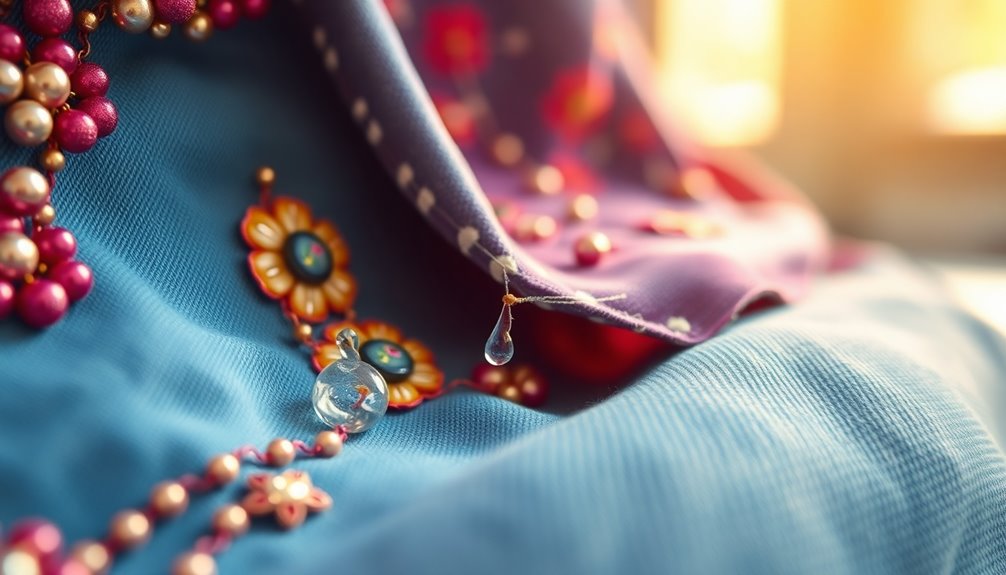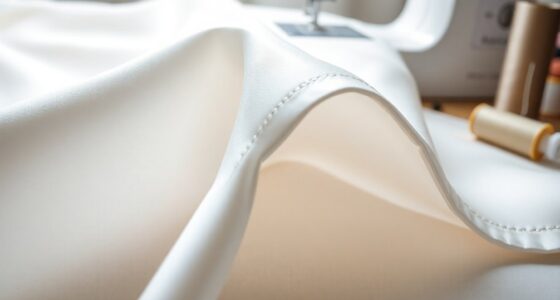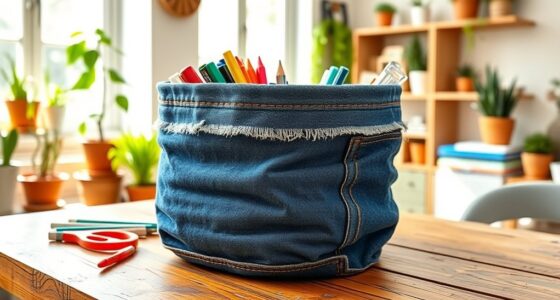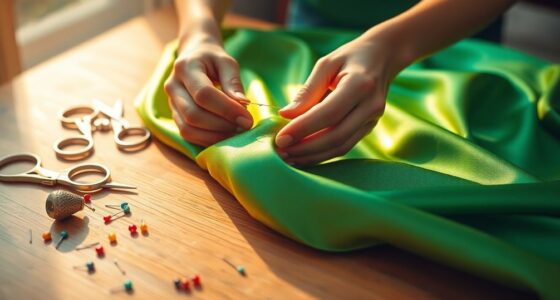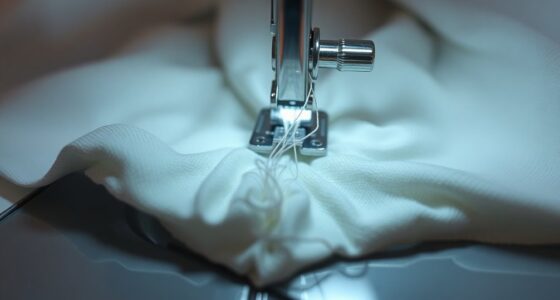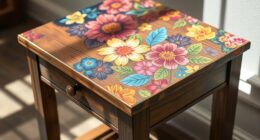Yes, fabric glue is indeed washable, providing strong adhesion that holds up well through multiple laundering cycles. It's designed to maintain its bond, even after repeated washes, keeping your fabric projects secure. Most fabric glues dry clear and remain flexible, so they won't alter the appearance of your materials. If you want to know more about different application techniques or which brands work best, stick around for further insights.
Key Takeaways
- Fabric glue is designed to be washable, maintaining strong adhesion even after multiple laundering cycles.
- Products like ECOGLUE GT-520S are specifically formulated to withstand water and washing without losing their bond.
- Many fabric glues dry clear and flexible, ensuring they do not alter the fabric's appearance post-wash.
- Eco-friendly fabric glues are often non-toxic and safe for skin contact, enhancing their usability for various projects.
- Proper application techniques, like even spreading and applying pressure, help maximize the washability and effectiveness of fabric glue.
Understanding Fabric Glue: What You Need to Know
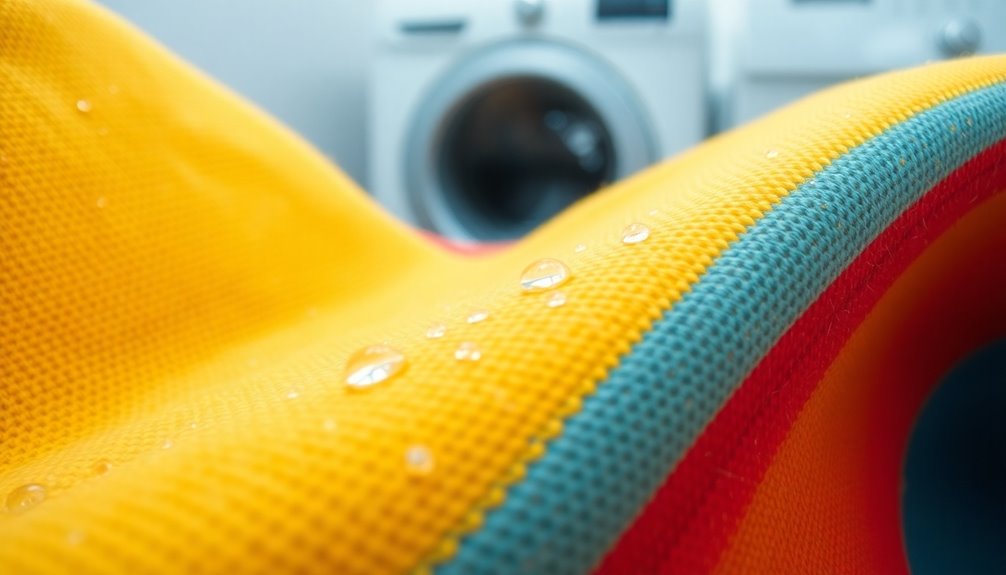
When you're diving into fabric projects, understanding fabric glue is essential. If you're looking for a fabric adhesive that holds strong even after washing, fabric glue is your best bet.
It's designed to be washable, ensuring your projects remain intact through multiple laundering cycles. Many options, like ECOGLUE GT-520S, are waterproof and UV resistant, so they can withstand various conditions without losing their bond.
Plus, the glue dries clear and stays soft, letting your fabric keep its original look without stiffness. Most fabric glues are non-toxic and safe for skin contact, making them ideal for crafting.
Proper application techniques, like spreading the glue evenly and applying pressure, would make all the difference in achieving a secure hold.
Characteristics of Washable Fabric Glue
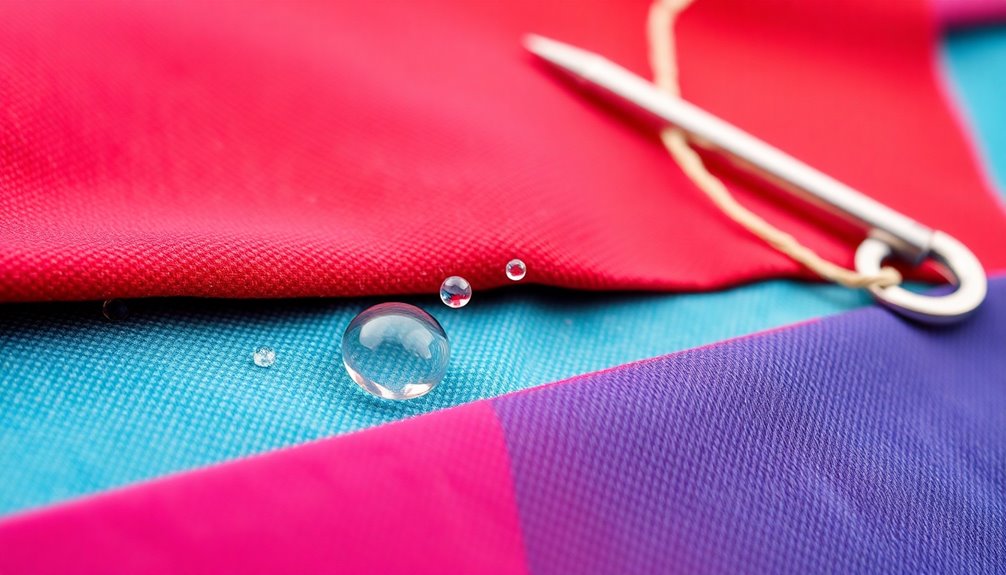
While many adhesives may falter in the wash, washable fabric glue is specifically engineered to endure multiple laundering cycles without losing its grip.
Take products like ECOGLUE GT-520S, which maintain strong adhesion even after repeated washes. You'll appreciate how it dries clear and soft, blending seamlessly with your fabric without altering its look.
Plus, it's waterproof and UV resistant, making it perfect for various environments. Many washable fabric glues are also non-toxic and safe for direct skin contact, so you can use them for different projects without worry.
For best results, use the precision nozzle for targeted application. If you have any questions, feel free to contact us!
I've also used this glue for my fabric repairs with great success.
How Fabric Glue Works With Different Fabrics
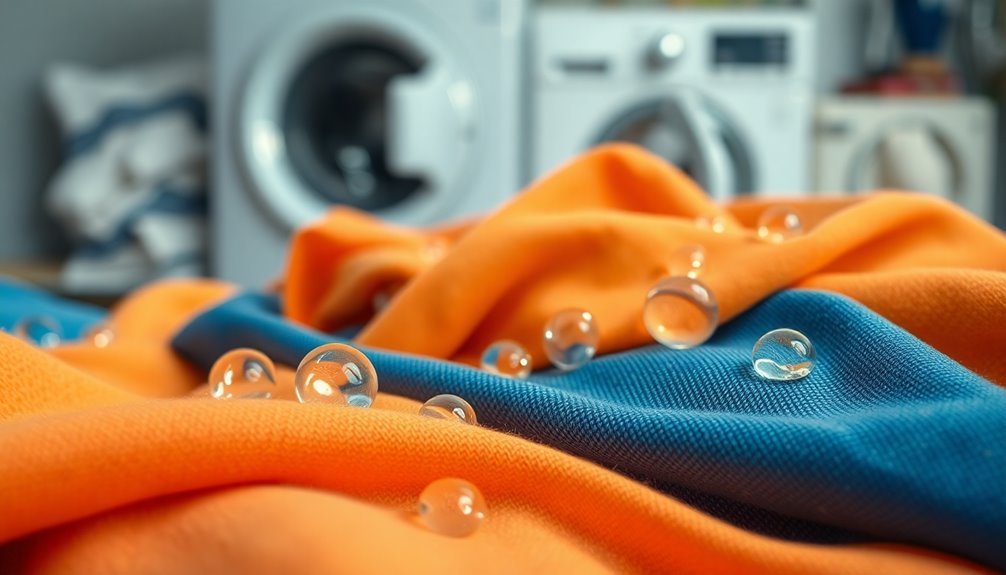
Fabric glue adapts remarkably well to various materials, allowing you to tackle a range of projects with confidence. For instance, ECOGLUE GT-520S works effectively on fabrics like cotton, denim, and leather.
Its washable nature guarantees strong adhesion even after multiple washes, making it reliable for everyday use. The glue dries clear and flexible, preserving the fabric's appearance while preventing stiffness that can arise from other adhesives.
Plus, its eco-friendly formula is safe for direct skin contact and won't stain. Many users find it durable and water-resistant, successfully using it to secure seams or apply patches without compromising the integrity of the fabric.
This versatility makes fabric glue an excellent choice for diverse crafting needs.
Application Techniques for Best Results
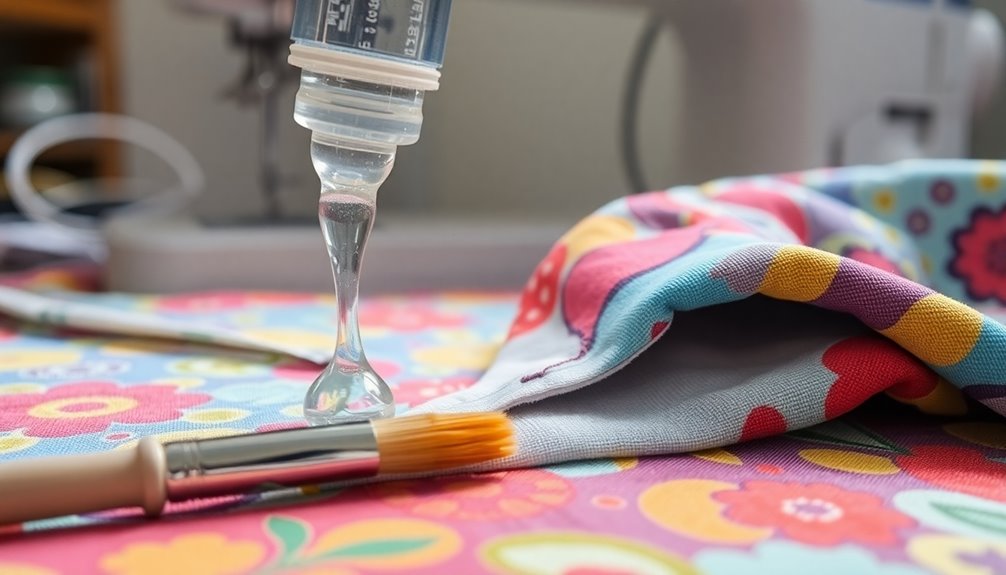
To achieve the best results with fabric glue, focus on even application and proper pressure. Use the precision nozzle with an open-ended needle tip for targeted application, which helps you control the amount of glue and prevents excess from spreading.
For added security, weave in the ends of your yarn and apply glue to keep them in place, enhancing durability. During the drying process, consider placing heavy objects on the glued areas to guarantee proper adhesion and prevent shifting.
Don't hesitate to experiment with different techniques, like gluing before adding padding, to discover what works best for your specific fabric and project type.
Environmental Impact of Fabric Glue
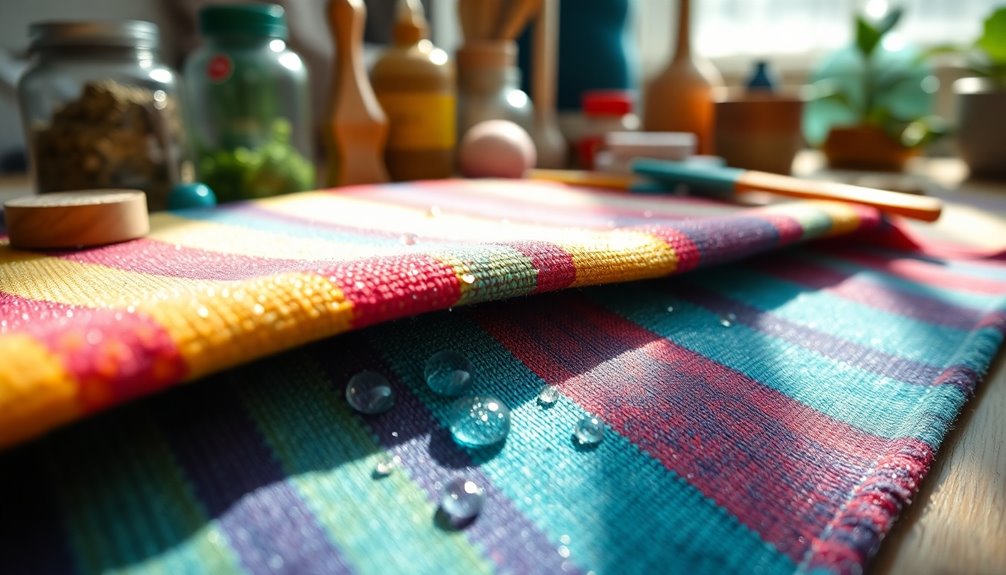
When you choose eco-friendly fabric glues, you're opting for formulations that minimize harm to both the environment and your health.
These glues are designed to be non-toxic and safe for skin contact, making your crafting experience safer.
Plus, using them in well-ventilated areas helps reduce any unpleasant odors, aligning with sustainable practices.
Eco-Friendly Formulations
While traditional adhesives often come with harsh chemicals that can harm the environment, many eco-friendly fabric glues offer a sustainable alternative.
Products like ECOGLUE GT-520S are formulated with eco-friendly ingredients that guarantee strong adhesion while minimizing environmental impact. You'll appreciate that these glues are safe for direct skin contact, reducing health risks during your crafting projects.
Unlike their conventional counterparts, eco-friendly fabric glues emit minimal odors, making your workspace more pleasant. Their water-based formulations lower volatile organic compounds (VOCs), promoting better indoor air quality.
Plus, many of these glues are washable, guaranteeing your fabric projects remain durable and long-lasting, all while being gentle on the planet. Choosing eco-friendly options is a win-win for you and the environment!
Safe Application Practices
Choosing eco-friendly fabric glues not only benefits the environment but also enhances your crafting experience through safe application practices.
These glues, like ECOGLUE GT-520S, are washable and maintain their bonding strength even after multiple washes, ensuring your projects last.
You'll appreciate that eco-friendly options are safe for direct skin contact, containing no harmful chemicals that could impact your health or the planet.
Just remember to work in a well-ventilated area, as some glues can emit odors that might affect those with sensitivities.
Plus, they dry clear and soft, preserving the fabric's original feel without stiffness.
With non-toxic and washable formulas, you can achieve a clean, professional finish while caring for both yourself and the environment.
Customer Experiences: Effectiveness and Sensitivity
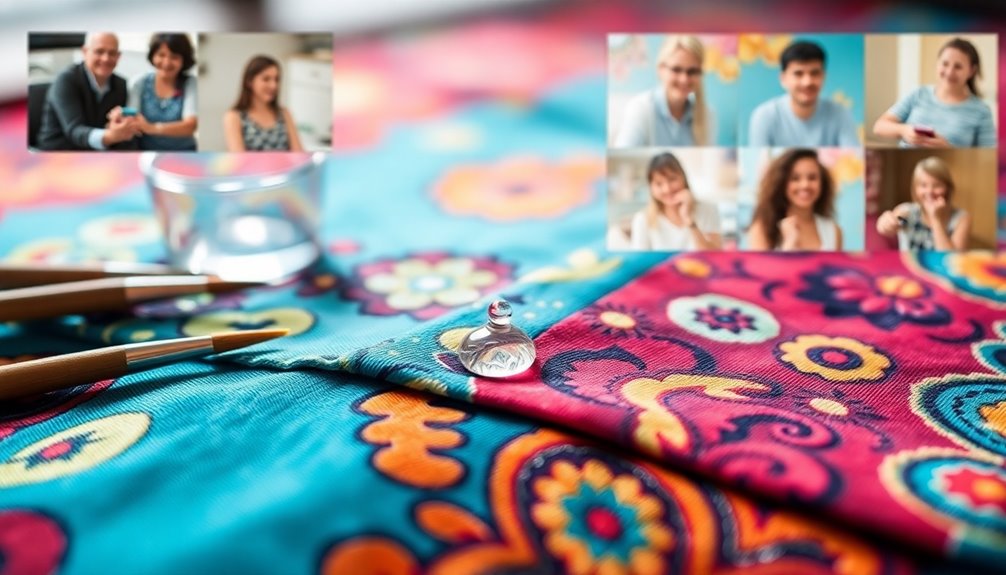
When using fabric glue, you'll likely notice its strong bonding capabilities, especially after multiple washes.
However, some users have reported sensitivity to the glue's odor, which might be a concern if you're sensitive to chemicals.
Sharing your own application success stories can help others find the right solutions for their fabric projects.
Bonding Strength Observations
Many customers have found that ECOGLUE GT-520S Fabric Glue excels in bonding strength, even after numerous washes, making it a reliable choice for fabric repairs.
You'll appreciate how it holds up in various applications, from securing seams to attaching embellishments. Users consistently praise its durability in laundry conditions, noting that the glue dries clear and soft.
This flexibility allows your finished pieces to remain comfortable, avoiding the scratchiness that comes with other adhesives.
While most experiences are positive, some users mentioned that the glue may not be the best option for specific tasks like hemming.
Odor Sensitivity Experiences
How do customers feel about the odor of fabric glue during application? Many users report sensitivity to the smell, prompting recommendations for those with chemical sensitivities to proceed with caution.
Despite this, the strong bonding capabilities of the glue often overshadow the odor concerns. Here are some key insights:
- Some users find the eco-friendly formula reduces irritation during use.
- While the glue dries clear and soft, some still note dissatisfaction with its effectiveness in specific projects like hemming pants.
- The precision nozzle design helps control application, potentially minimizing odor.
- Overall, experiences vary, with several praising the bonding strength while others remain cautious due to odor sensitivity.
Balancing effectiveness and comfort is essential when choosing fabric glue.
Application Success Stories
While some users express concern about odor sensitivity, countless success stories highlight the effectiveness of ECOGLUE GT-520S Fabric Glue in various applications.
Customers rave about its strong bond, even after multiple washes, proving its durability for diverse fabric needs. The precision nozzle design allows for targeted application, ensuring neat results without excess glue ruining your projects.
Users appreciate its eco-friendly formula, which is safe for direct skin contact and doesn't stain fabrics, making it ideal for sensitive tasks. Though a few mention sensitivity to the glue's odor, they recommend working in well-ventilated areas.
Comparing Fabric Glue Brands
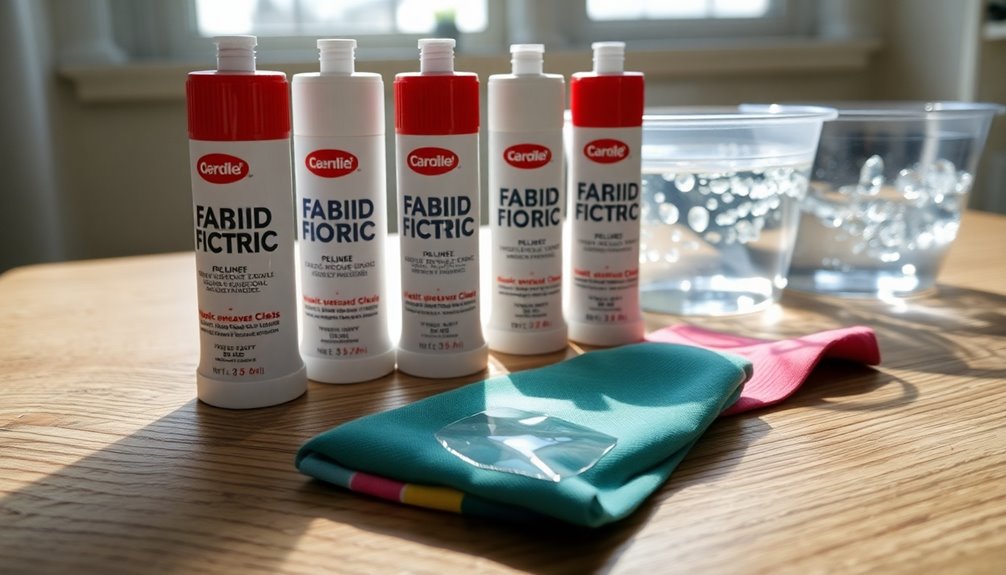
Which fabric glue brand is best for your project? The choice largely depends on your specific needs and application.
Here are some key points to take into account when comparing brands:
- ECOGLUE GT-520S: Designed for permanent adhesion and is washable after multiple washes.
- June Tailor Fray Block: Excellent for preventing fabric fraying, as it doesn't wash out over time.
- Dritz Fray Check: Effective but can stain fabric if not applied carefully; precision is vital.
- Applicator Design: Varies by brand, affecting ease of application and effectiveness for targeted use.
Tips for Maintaining Fabric Integrity
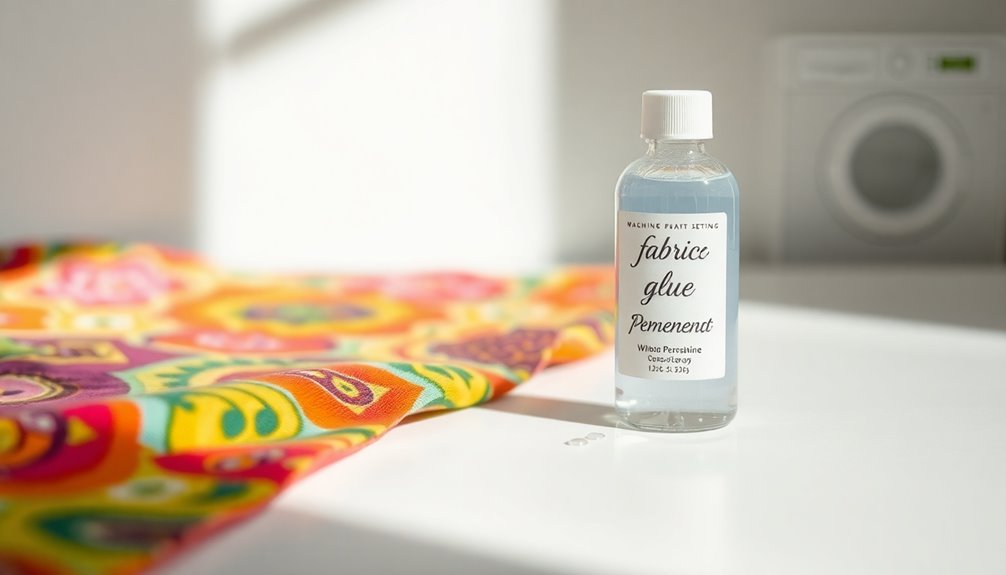
Choosing the right fabric glue is just the start—maintaining the integrity of your fabric is just as important.
Always opt for a washable fabric glue that can hold up through multiple wash cycles without losing its bond. Before you apply the glue, make certain the fabric is clean and dry to guarantee the best adhesion.
It's essential to follow the manufacturer's instructions regarding application and drying times; improper methods can weaken the fabric over time. Test the glue on a small, hidden area first to check for compatibility and avoid staining.
Additionally, consider using hand stitching or fusible tricot to reinforce seams and secure edges, which will boost the durability of your project alongside the fabric glue.
Addressing Common Concerns With Fabric Glue
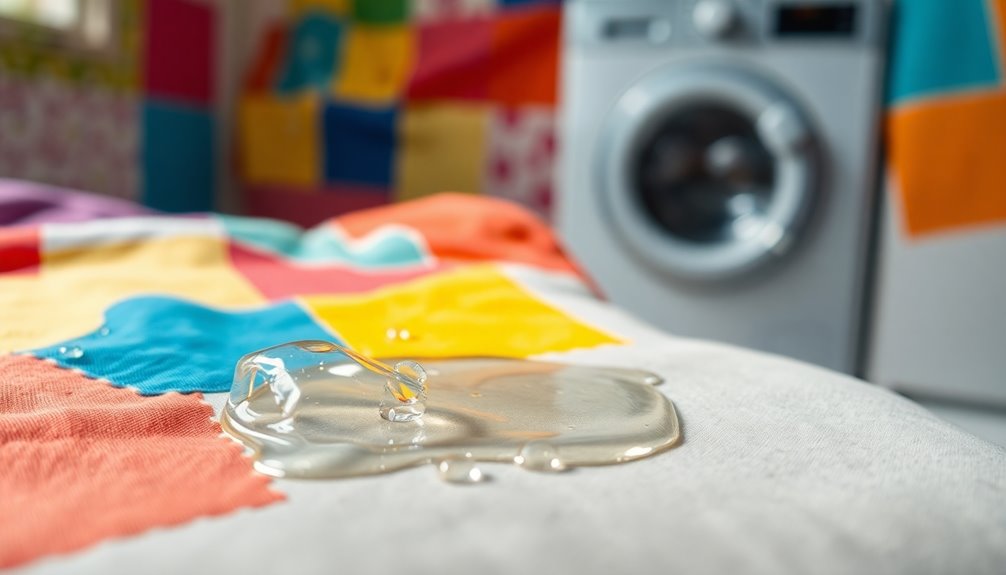
When it comes to using fabric glue, you might've some concerns about its washability and overall performance.
Rest assured, many fabric glues are designed to withstand multiple washes without losing their adhesion. Here are some common concerns you might have:
- Washability: Many formulations, like ECOGLUE GT-520S, maintain strong adhesion after washing.
- Appearance: Most fabric glues dry clear and soft, preserving the fabric's look.
- Skin Safety: Eco-friendly options are safe for skin contact and won't stain.
- Odor Sensitivity: Some brands may have noticeable odors, so apply with care if you have sensitivities.
Final Thoughts on Using Fabric Glue
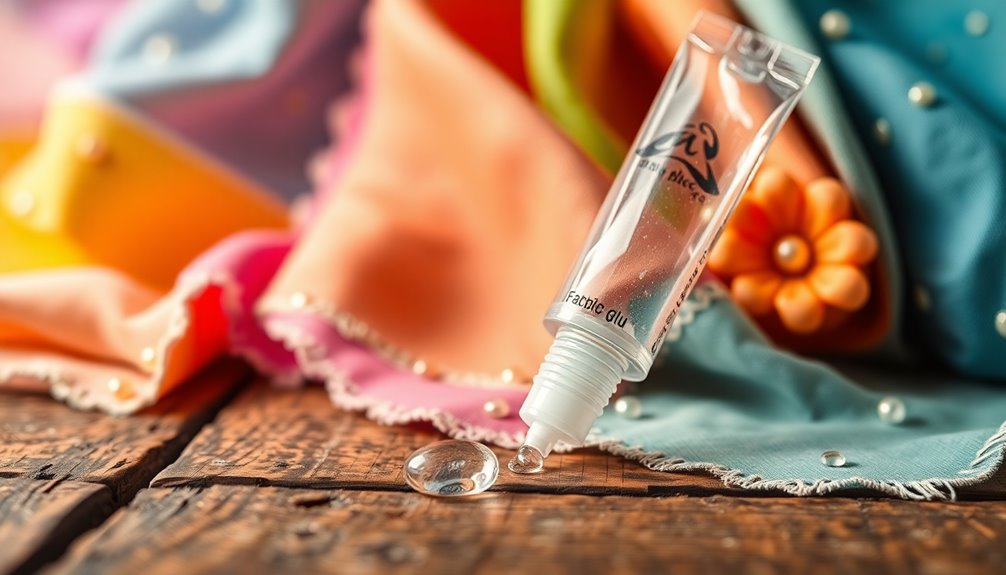
When using fabric glue, you'll want to focus on its durability after washing to guarantee your projects stand the test of time.
Applying the glue evenly and using proper techniques can greatly enhance its bond strength.
Keep these tips in mind for a successful and lasting finish on your fabric creations.
Durability After Washing
Although you might worry about the longevity of fabric glue after washing, many options on the market, like ECOGLUE GT-520S, are designed to withstand multiple cycles without losing their hold.
When applied correctly, these adhesives can provide long-lasting results. Here are some key points to take into account:
- Choose fabric glue formulated for your specific materials to guarantee maximum durability.
- Proper application is essential; follow instructions for even distribution and adequate drying time.
- Many fabric glues dry clear and soft, preserving the garment's original look and feel.
- Reviews show that well-applied glues don't wash out, making them ideal for repairs and embellishments.
With the right product and technique, you can enjoy durable results even after washing.
Application Tips and Techniques
To achieve the best results with fabric glue, focus on techniques that promote a strong bond and a tidy finish.
Use the precision nozzle for targeted application, avoiding excess glue. After spreading the glue evenly, apply firm pressure to secure the fabrics together, allowing it to dry fully for 24 hours for maximum adhesion.
Don't hesitate to experiment—try gluing yarn ends or using heavy objects to keep pieces in place while drying.
Always choose fabric glues labeled as wash-resistant and non-toxic to guarantee durability through multiple washes.
Finally, work in well-ventilated areas to minimize any sensitivity to odors.
Following these tips will help you achieve a clean and long-lasting finish in your fabric projects.
Frequently Asked Questions
What Happens to Fabric Glue When Washed?
When you wash fabric glued items, the glue generally holds up well, maintaining its bond through multiple cycles.
Most fabric glues are designed to be washable, but it's essential you follow the manufacturer's instructions for drying and curing.
If applied correctly, the glue should stay intact, but some products might stain or discolor your fabric if they don't dry clear.
Always check the specifics of your glue for the best results.
Is Fabric Glue Washable?
Using fabric glue is like planting seeds in a garden; with care, you'll see them flourish.
Yes, fabric glue is generally washable, but its durability depends on the brand. Most types, like ECOGLUE GT-520S, maintain their hold after washes.
To guarantee the best results, you should always follow the manufacturer's instructions regarding drying and curing times.
What Are the Disadvantages of Fabric Glue?
When using fabric glue, you might find a few disadvantages. It may not be as durable as sewing, especially for high-stress areas, and could fail after multiple washes.
Additionally, some glues can leave a stiff texture, making your fabric uncomfortable. You also need to be cautious about fabric compatibility, as certain glues don't work well on synthetic fibers.
Plus, the strong odors during application might be bothersome if you have chemical sensitivities.
Does Fabric Glue Prevent Fraying?
Think of fabric glue as a protective shield for your textiles. Yes, it does prevent fraying! When you apply it to raw edges, it seals them like a cozy blanket wraps around you on a chilly night.
This secure bond keeps your fabric intact, allowing for flexibility without stiffness. To enhance its effectiveness, spread the glue evenly and let it dry completely. Additionally, this innovative adhesive is designed to accommodate the viscose fabric stretch properties, ensuring that your fabric retains its natural movement and drape. By properly applying the glue, you can prevent any potential cracking or peeling, thus maintaining the integrity of your project. Remember to test a small area first to ensure compatibility and achieve the best results.
Combine it with hand stitching for extra durability, and your fabric will stay fray-free.
Conclusion
In the end, understanding fabric glue is key to your crafting success. Whether you're working on a quick fix or a detailed project, knowing if it's washable can save you a lot of heartache down the line. So, don't throw caution to the wind—choose the right glue for your fabric type and follow the application tips for lasting results. With a little care, you can keep your creations looking great for years to come.
